Rotavirus infection induces an increase in intracellular calcium concentration in human intestinal epithelial cells: role in microvillar actin alteration
- PMID: 10666263
- PMCID: PMC111714
- DOI: 10.1128/jvi.74.5.2323-2332.2000
Rotavirus infection induces an increase in intracellular calcium concentration in human intestinal epithelial cells: role in microvillar actin alteration
Abstract
Rotaviruses, which infect mature enterocytes of the small intestine, are recognized as the most important cause of viral gastroenteritis in young children. We have previously reported that rotavirus infection induces microvillar F-actin disassembly in human intestinal epithelial Caco-2 cells (N. Jourdan, J. P. Brunet, C. Sapin, A. Blais, J. Cotte-Laffitte, F. Forestier, A. M. Quero, G. Trugnan, and A. L. Servin, J. Virol. 72:7228-7236, 1998). In this study, to determine the mechanism responsible for rotavirus-induced F-actin alteration, we investigated the effect of infection on intracellular calcium concentration ([Ca(2+)](i)) in Caco-2 cells, since Ca(2+) is known to be a determinant factor for actin cytoskeleton regulation. As measured by quin2 fluorescence, viral replication induced a progressive increase in [Ca(2+)](i) from 7 h postinfection, which was shown to be necessary and sufficient for microvillar F-actin disassembly. During the first hours of infection, the increase in [Ca(2+)](i) was related only to an increase in Ca(2+) permeability of plasmalemma. At a late stage of infection, [Ca(2+)](i) elevation was due to both extracellular Ca(2+) influx and Ca(2+) release from the intracellular organelles, mainly the endoplasmic reticulum (ER). We noted that at this time the [Ca(2+)](i) increase was partially related to a phospholipase C (PLC)-dependent mechanism, which probably explains the Ca(2+) release from the ER. We also demonstrated for the first time that viral proteins or peptides, released into culture supernatants of rotavirus-infected Caco-2 cells, induced a transient increase in [Ca(2+)](i) of uninfected Caco-2 cells, by a PLC-dependent efflux of Ca(2+) from the ER and by extracellular Ca(2+) influx. These supernatants induced a Ca(2+)-dependent microvillar F-actin alteration in uninfected Caco-2 cells, thus participating in rotavirus pathogenesis.
Figures
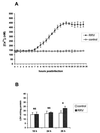
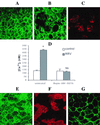
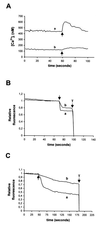
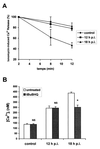

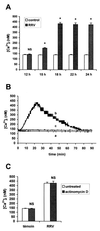

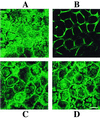

Similar articles
-
Rotavirus infection reduces sucrase-isomaltase expression in human intestinal epithelial cells by perturbing protein targeting and organization of microvillar cytoskeleton.J Virol. 1998 Sep;72(9):7228-36. doi: 10.1128/JVI.72.9.7228-7236.1998. J Virol. 1998. PMID: 9696817 Free PMC article.
-
Rotavirus infection induces cytoskeleton disorganization in human intestinal epithelial cells: implication of an increase in intracellular calcium concentration.J Virol. 2000 Nov;74(22):10801-6. doi: 10.1128/jvi.74.22.10801-10806.2000. J Virol. 2000. PMID: 11044126 Free PMC article.
-
Mechanism of extracellular calcium regulation of intestinal epithelial tight junction permeability: role of cytoskeletal involvement.Microsc Res Tech. 2000 Oct 15;51(2):156-68. doi: 10.1002/1097-0029(20001015)51:2<156::AID-JEMT7>3.0.CO;2-J. Microsc Res Tech. 2000. PMID: 11054866
-
Microvillar Ca++ signaling: a new view of an old problem.J Cell Physiol. 1999 Jul;180(1):19-34. doi: 10.1002/(SICI)1097-4652(199907)180:1<19::AID-JCP3>3.0.CO;2-K. J Cell Physiol. 1999. PMID: 10362014 Review.
-
Baculovirus infectivity and the actin cytoskeleton.Curr Drug Targets. 2007 Oct;8(10):1075-83. doi: 10.2174/138945007782151379. Curr Drug Targets. 2007. PMID: 17979667 Review.
Cited by
-
Gastrointestinal organoids in the study of viral infections.Am J Physiol Gastrointest Liver Physiol. 2023 Jan 1;324(1):G51-G59. doi: 10.1152/ajpgi.00152.2022. Epub 2022 Nov 22. Am J Physiol Gastrointest Liver Physiol. 2023. PMID: 36414538 Free PMC article. Review.
-
Structural Insights into the Unique Activation Mechanisms of a Non-classical Calpain and Its Disease-Causing Variants.Cell Rep. 2020 Jan 21;30(3):881-892.e5. doi: 10.1016/j.celrep.2019.12.077. Cell Rep. 2020. PMID: 31968260 Free PMC article.
-
Mutational analysis of the rotavirus NSP4 enterotoxic domain that binds to caveolin-1.Virol J. 2013 Nov 13;10:336. doi: 10.1186/1743-422X-10-336. Virol J. 2013. PMID: 24220211 Free PMC article.
-
Pathophysiology of diarrhea in calves.Vet Clin North Am Food Anim Pract. 2009 Mar;25(1):13-36, xi. doi: 10.1016/j.cvfa.2008.10.013. Vet Clin North Am Food Anim Pract. 2009. PMID: 19174281 Free PMC article. Review.
-
Identification of cellular calcium binding protein calmodulin as a regulator of rotavirus A infection during comparative proteomic study.PLoS One. 2013;8(2):e56655. doi: 10.1371/journal.pone.0056655. Epub 2013 Feb 20. PLoS One. 2013. PMID: 23437200 Free PMC article.
References
-
- Ball J M, Tian P, Zeng C Q-Y, Morris A P, Estes M K. Age-dependent diarrhea induced by a rotaviral nonstructural glycoprotein. Science. 1996;272:101–104. - PubMed
-
- Berridge M J. Inositol trisphosphate and calcium signalling. Nature. 1993;361:315–325. - PubMed
-
- Bishop R F, Davidson G P, Holmes I H, Ruck B J. Virus particles in epithelial cells of duodenal mucosa from children with acute non-bacterial gastroenteritis. Lancet. 1973;ii:1281–1283. - PubMed
-
- Bleasdale J E, Thakur N R, Gremban R S, Bundy G L, Fitzpatrick F A, Smith R J, Bunting S. Selective inhibition of receptor-coupled phospholipase C-dependent processes in human platelets and polymorphonuclear neutrophils. J Pharmacol Exp Ther. 1990;255:756–768. - PubMed
Publication types
MeSH terms
Substances
LinkOut - more resources
Full Text Sources
Other Literature Sources
Research Materials
Miscellaneous

